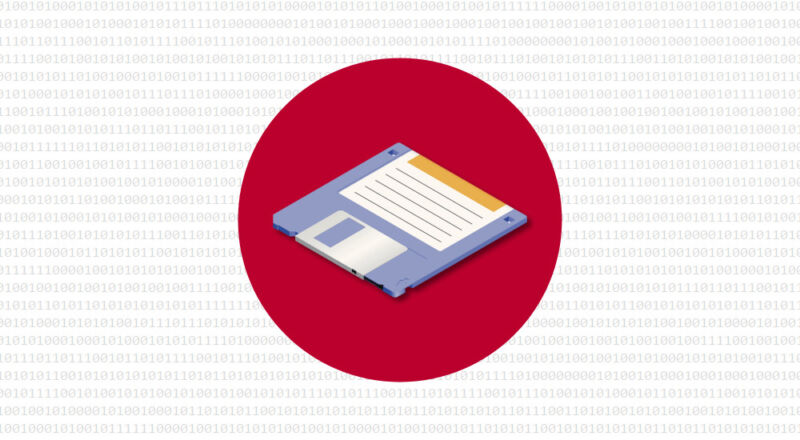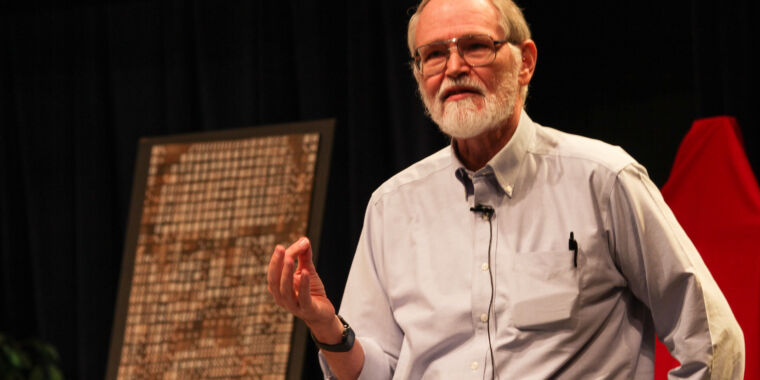
Wednesday, August 31, 2022
U.S. Restricts Sales of Sophisticated Chips to China and Russia

Microsoft finds TikTok vulnerability that allowed one-click account compromises


Enlarge (credit: Getty Images)
Microsoft said on Wednesday that it recently identified a vulnerability in TikTok's Android app that could allow attackers to hijack accounts when users did nothing more than click on a single errant link. The software maker said it notified TikTok of the vulnerability in February and that the China-based social media company has since fixed the flaw, which is tracked as CVE-2022-28799.
The vulnerability resided in how the app verified what's known as deeplinks, which are Android-specific hyperlinks for accessing individual components within a mobile app. Deeplinks must be declared in an app's manifest for use outside of the app so, for example, someone who clicks on a TikTok link in a browser has the content automatically opened in the TikTok app.
An app can also cryptographically declare the validity of a URL domain. TikTok on Android, for instance, declares the domain m.tiktok.com. Normally, the TikTok app will allow content from tiktok.com to be loaded into its WebView component but forbid WebView from loading content from other domains.
FCC has approved $6 billion in broadband grants despite rejecting Starlink


Several US government agencies are having a busy week for doling out broadband deployment funding to ISPs and state governments. Today, the FCC announced $791.6 million for six broadband providers, covering network expansions to over 350,000 homes and businesses in 19 states. The ISPs will receive the money over 10 years.
"This round of funding supports projects using a range of network technologies, including gigabit service hybrid fiber/fixed wireless deployments that will provide end-user locations with either fiber or fixed wireless network service using licensed spectrum," the FCC said. Funded ISPs include Nextlink Internet and Starry.
Separately, the Treasury Department and National Telecommunications and Information Administration (NTIA) this week announced new grants for states and Tribal entities (more on that later in this article).
AI wins state fair art contest, annoys humans


Enlarge / The winning entry, Théåtre D'opéra Spatial. (credit: Jason Allen)
A synthetic media artist named Jason Allen entered AI-generated artwork into the Colorado State Fair fine arts competition and announced last week that he won first place in the Digital Arts/Digitally Manipulated Photography category, Vice reported Wednesday based on a viral tweet.
Allen used Midjourney—a commercial image synthesis model available through a Discord server—to create a series of three images. He then upscaled them, printed them on canvas, and submitted them to the competition in early August. To his delight, one of the images (titled Théåtre D'opéra Spatial) captured the top prize, and he posted about his victory on the Midjourney Discord server on Friday.

Allen’s Discord post announcing victory. (credit: MidJourney Discord)
Allen's victory prompted lively discussions on Twitter, Reddit, and the Midjourney Discord server about the nature of art and what it means to be an artist. Some commenters think human artistry is doomed thanks to AI and that all artists are destined to be replaced by machines. Others think art will evolve and adapt with new technologies that come along, citing synthesizers in music. It's a hot debate that Wired covered in July.
Japan declares war on floppy disks for government use


Enlarge (credit: Benj Edwards / Getty Images)
Japan's newly appointed Minister of Digital Affairs, Taro Kono, has declared war on the floppy disk and other forms of obsolete media, which the government still requires as a submission medium for around 1,900 types of business applications and other forms. The goal is to modernize the procedures by moving the information submission process online.
Kono announced the initiative during a press conference in Japan on Tuesday, according to Bloomberg. Legal issues have prevented the modernization to cloud data storage in the past, and Japanese government offices often use CDs, MiniDiscs, or floppy disks to accept submissions from the public and businesses. For example, Japan's Mainichi newspaper reported in December 2021 that Tokyo police lost two floppy disks containing information on 38 public housing applicants. A digital task force group led by Kono will announce how to fix those issues by the end of the year.
Digital Minister declares a war on floppy discs.
— KONO Taro (@konotaromp) August 31, 2022
There are about 1900 government procedures that requires business community to use discs, i. e. floppy disc, CD, MD, etc to submit applications and other forms. Digital Agency is to change those regulations so you can use online.
Shortly after taking office earlier this month, Kono announced his desire to modernize technology in the Japanese government, speaking out about Japan's reliance on hanko hand stamps during the COVID-19 pandemic and fax machines instead of email. He's also been outspoken about the subject on Twitter.
Many Developed Countries View Online Misinformation as ‘Major Threat’

Doug Mastriano’s Extremely Online Rise to Republicans’ Governor Nominee in Pa.

Some Carmakers Say Recycling Car Parts Is the Future. But Is It Realistic?

Tuesday, August 30, 2022
France reveals hidden swimming pools with AI, taxes them


Enlarge (credit: Getty Images)
Using an artificial intelligence computer vision system developed by French IT firm Capgemini, the French tax office (often called "Le Fisc") has identified 20,356 residential swimming pools that had previously gone undeclared. According to The Guardian, this has opened up €10 million in additional tax revenue, leading the way to the government taxing other undeclared architectural features such as annexes or verandas.
To find undeclared pools, Capgemini's software—with help from Google's cloud processing—automatically recognizes pools in aerial photographs (by looking for blue rectangles, for instance) and compares the results to records in real estate and tax databases. If it finds that a relevant address doesn't have a pool registered, the owner is in violation of tax law. The program began last October on a limited basis, covering only nine out of 96 metropolitan departments. At first, the system confused solar panels for swimming pools with an error rate of 30 percent, but Le Fisc says that it has since increased the accuracy.
The French government taxes real estate based on its rental value, which increases when owners build additions or improvements such as swimming pools. For example, a 30 square meter swimming pool will result in around €200 of extra taxes per year. Private pools have lately become more popular in France due to the recent heat wave, but they're also controversial due to their water usage during a historic drought.
Sweeping Children’s Online Safety Bill Is Passed in California

Google Employee Who Played Key Role in Protest of Contract With Israel Quits

The Animal Translators

Monday, August 29, 2022
A Who’s Who of Silicon Valley Lawyers Up for the Musk-Twitter Trial

Xi Jinping’s Vision for Tech Self-Reliance in China Runs Into Reality

‘The Eye of the Storm’: Taiwan Is Caught in a Great Game Over Microchips

Sunday, August 28, 2022
NASA’s Artemis I Revives the Moonshot


“When you look at the rocket, it looks almost retro,” said Bill Nelson, the administrator of NASA. “Looks like we’re looking back toward the Saturn V. But it’s a totally different, new, highly sophisticated–more sophisticated–rocket, and spacecraft.”
Artemis, powered by the Space Launch System rocket, is America’s first attempt to send astronauts to the moon since Apollo 17 in 1972, and technology has taken giant leaps since then. On Artemis I, the first test flight, mission managers say they are taking the SLS, with its uncrewed Orion spacecraft up top, and “stressing it beyond what it is designed for”—the better to ensure safe flights when astronauts make their first landings, currently targeted to begin with Artemis III in 2025.
But Nelson is right: The rocket is retro in many ways, borrowing heavily from the space shuttles America flew for 30 years, and from the Apollo-Saturn V.
Much of Artemis’ hardware is refurbished: Its four main engines, and parts of its two strap-on boosters, all flew before on shuttle missions. The rocket’s apricot color comes from spray-on insulation much like the foam on the shuttle’s external tank. And the large maneuvering engine in Orion’s service module is actually 40 years old—used on 19 space shuttle flights between 1984 and 1992.
“I have a name for missions that use too much new technology—failures.”
—John Casani, NASA
Perhaps more importantly, the project inherits basic engineering from half a century of spaceflight. Just look at Orion’s crew capsule—a truncated cone, somewhat larger than the Apollo Command Module but conceptually very similar.
Old, of course, does not mean bad. NASA says there is no need to reinvent things engineers got right the first time.
“There are certain fundamental aspects of deep space exploration that are really independent of money,” says Jim Geffre, Orion Vehicle Integration Manager at the Johnson Space Center in Houston. “The laws of physics haven’t changed since the 1960s. And capsule shapes happen to be really good for coming back into the atmosphere at Mach 32.”
Roger Launius, who served as NASA’s chief historian from 1990 to 2002 and as a curator at the Smithsonian Institution from then until 2017, tells of a conversation he had with John Casani, a veteran NASA engineer who managed the Voyager, Galileo and Cassini probes to the outer planets.
“I have a name for missions that use too much new technology,” he recalls Casani saying. “Failures.”
The Artemis I flight is slated for about six weeks. (Apollo 11 lasted eight days.) The ship roughly follows Apollo’s path to the moon’s vicinity, but then puts itself in what NASA calls a distant retrograde orbit. It swoops within 110 km of the lunar surface for a gravity assist, then heads 64,000 km out—taking more than a month but using less fuel than it would in closer orbits. Finally, it comes home, reentering the Earth’s atmosphere at 11 km per second, slowing itself with a heatshield and parachutes, and splashing down in the Pacific not far from San Diego.
If all four, quadruply-redundant flight computer modules fail, there is a fifth, entirely separate computer onboard, running different code to get the spacecraft home.
“That extra time in space,” says Geffre, “allows us to operate the systems, give more time in deep space, and all those things that stress it, like radiation and micrometeoroids, thermal environments.”
There are, of course, newer technologies on board. Orion is controlled by two vehicle management computers, each comprised of two flight computer modules (FCMs) to handle guidance, navigation, propulsion, communications and other systems. The flight control system, Geffre points out, is quad-redundant; if at any point one of the four FCMs disagrees with the others, it will take itself offline and, in a 22-second process, reset itself to make sure its outputs are consistent with the others’. If all four FCMs fail, there is a fifth, entirely separate computer running different code to get the spacecraft home.
Guidance and navigation, too, have advanced since the sextant used on Apollo. Orion uses a star tracker to determine its attitude, imaging stars and comparing them to an onboard database. And an optical navigation camera shoots the Earth and moon so that guidance software can determine their distance and position and keep the spacecraft on course. NASA says it’s there as backup, able to get Orion to a safe splashdown even if all communication with Earth has been lost.
But even those systems aren’t entirely new. Geffre points out that the guidance system’s architecture is derived from the Boeing 787. Computing power in deep space is limited by cosmic radiation, which can corrupt the output of microprocessors beyond the protection of Earth’s atmosphere and magnetic field.
Beyond that is the inevitable issue of cost. Artemis is a giant project, years behind schedule, started long before NASA began to buy other launches from companies like SpaceX and Rocket Lab. NASA’s inspector general, Paul Martin, testified to Congress in March that the first four Artemis missions would cost US $4.1 billion each – “a price tag that strikes us as unsustainable.”
Launius, for one, rejects the argument that government is inherently wasteful. “Yes, NASA’s had problems in managing programs in the past. Who hasn’t?” he says. He points out that Blue Origin and SpaceX have had plenty of setbacks of their own – they’re just not obliged to be public about them. “I could go on and on. It’s not a government thing per se and it’s not a NASA thing per se.”
So why return to the moon with – please forgive the pun – such a retro rocket? Partly, say those who watch Artemis closely, because it’s become too big to fail, with so much American money and brainpower invested in it. Partly because it turns NASA’s astronauts outward again, exploring instead of maintaining a space station. Partly because new perspectives could come of it. And partly because China and Russia have ambitions in space that threaten America’s.
“Apollo was a demonstration of technological verisimilitude – to the whole world,” says Launius. “And the whole world knew then, as they know today, that the future belongs to the civilization that can master science and technology.”
Reference: https://ift.tt/mH5GNP1Friday, August 26, 2022
A Journey Into Misinformation on Social Media

Thursday, August 25, 2022
Phishers who hit Twilio and Cloudflare stole 10k credentials from 136 others


Enlarge / This is definitely not a Razer mouse—but you get the idea. (credit: calvio via Getty Images)
Two weeks ago, Twilio and Cloudflare detailed a phishing attack so methodical and well-orchestrated that it tricked employees from both companies into revealing their account credentials. In the case of Twilio, the attack overrode its 2FA protection and gave the threat actors access to its internal systems. Now, researchers have unearthed evidence the attacks were part of a massive phishing campaign that netted almost 10,000 account credentials belonging to 130 organizations.
Based on the revelations provided by Twilio and Cloudflare, it was already clear that the phishing attacks were executed with almost surgical precision and planning. Somehow, the threat actor had obtained private phone numbers of employees and, in some cases, their family members. The attackers then sent text messages that urged the employees to log in to what appeared to be their employers' legitimate authentication page.
In 40 minutes, 76 Cloudflare employees received the text message, which included a domain name registered only 40 minutes earlier, thwarting safeguards the company has in place to detect sites that spoof its name. The phishers also used a proxy site to perform hijacks in real time, a method that allowed them to capture the one-time passcodes Twilio used in its 2FA verifications and enter them into the real site. Almost immediately, the threat actor used its access to Twilio's network to obtain phone numbers belonging to 1,900 users of the Signal Messenger.
Why Peloton Is Selling on Amazon

Dead Pig’s Restored Organs Give Hope for Transplants


After animals die, rapid biological and chemical processes begin to destroy cells and organs. Previous research on pig brains showed that a treatment the researchers called BrainEx could slow or reverse some of these processes. Now, the team has shown that a modified version of the previous technology, called OrganEx, can create some of the same effects when applied to the entire body of a pig, reversing the deterioration of cells in the liver, heart, kidneys, and other organs after death. Though the preliminary research is far from being used with humans, the researchers say that it could eventually help keep organs viable for donations for longer after an organ donor dies. The research also raises a number of ethical questions, from the welfare of animals to the future allocation of medical resources.
“We have shown that certain cellular functions can be restored in the brain following several hours after cessation of blood flow,” said authors Dr. David Andrijevic, Zvonimir Vrselja, and Dr. Nenad Sestan, of Yale University’s Department of Neuroscience via email. “We wanted to see whether the same observations could also be seen across multiple vital organs in the whole body.”
Researchers first induced cardiac arrest in anesthetized pigs. Then, they waited one hour before applying their system to the pigs’ bodies. OrganEx is a two-part system, including a device similar to a heart-lung machine used to keep patients alive during major heart surgery. The device helps to restore blood circulation and distribute the second part of the technology, a special solution containing ingredients designed to protect cells and restore some cell and organ function. These ingredients include an artificial oxygen-carrier similar to hemoglobin, amino acids, vitamins, and over 13 drugs meant to reduce inflammation and cell death.
Researchers found that the OrganEx process helped preserve the structure of organs and cells. In addition, they found, many revived organ cells worked similarly to cells in living pigs. These cells—including cells in the heart, liver, and kidneys—also had genetic signatures showing they were repairing themselves.
According to Jerzy Kupiec-Weglinski, a professor of surgery, pathology and laboratory medicine at the David Geffen School of Medicine at UCLA, “the ‘resurrection’ of the brain” under OrganEx’s six-hour-long treatment is “most striking.” The accomplishment is all the more remarkable, he says, for the hour postmortem that the tissue had been deprived of oxygen.
The OrganEx treatment preserved the cellular structure of brain cells, and even some electrical activity in the brain, though nowhere near the amount of activity that would mean the pigs were conscious. The pigs also had some sporadic movements that the researchers said they do not completely understand.
OrganEx is still in the early stages of testing and development and would need to go through more stages of animal research as well as the clinical trial process before it might be used in humans. But, write the study’s authors, the technology ultimately promises to extend the time after death that organs are viable for transplantation.
“The lack of donor organs is the major problem in our field, and people are dying while waiting for the life-saving organ transplant,” said Kupiec-Weglinski via email. (Kupiec-Weglinski is also director of the Dumont-UCLA Transplantation Research Center.)
The OrganEx research also raises a number of ethical questions, including redefining what death is, says Paul Root Wolpe, a bioethicist and director of the Center for Ethics at Emory University.
“Death is the cessation of organized metabolic activity,” he says. “If this process begins to reanimate metabolic activity, then you really are talking about the very, very early first rudimentary possible steps of reversing death.” If researchers were able to restore more activity in the brain, he notes, it could also become difficult to determine if the animals are conscious. Research on coma patients has shown that we don’t always know if humans are conscious based on brain activity alone.
Future use of the new technology could also raise questions about the use of medical resources, says Maksim Plikus, a professor of developmental biology at the University of California, Irvine who was not involved with the study. Right now, people who are brain-dead are sometimes left on life support, even if there is minimal chance of recovery, draining valuable medical resources. If such technologies could one day restore organ function—though not necessarily brain function—in someone who is clinically dead, this dilemma could become more common, he says.
For their part, the Yale team doesn’t view their research, published this month in the journal Nature, as redefining death.
“In our work, we are more focused [on] cellular and organ recovery,” the authors said. “That is what we would like to continue focusing on in the future.”
Reference: https://ift.tt/KGTZmn0Spiders Are Caught in a Global Web of Misinformation

Peloton Reports a $1.2 Billion Loss as Sales Slow

Judge John Hodgman on Taking the Chargers

Wednesday, August 24, 2022
Facebook, Twitter and Others Remove Pro-U.S. Influence Campaign

Peloton Will Sell Fitness Equipment and Apparel on Amazon

A 5-Step Checklist for Handling Air Travel Woes on the Go

A 5-Step Checklist for Handling Air Travel Woes on the Go

Can Technology Help Cities Manage Curbs Better?

Tuesday, August 23, 2022
Unix legend, who owes us nothing, keeps fixing foundational AWK code


Enlarge / Brian Kernighan speaking at a tribute to his Bell Labs coworker and The C Programming Language co-author Dennis Ritchie in 2012. Ritchie's visage in dominoes is behind Kernighan. (credit: Ben Lowe/Flickr)
A Princeton professor, finding a little time for himself in the summer academic lull, emailed an old friend a couple months ago. Brian Kernighan said hello, asked how their US visit was going, and dropped off hundreds of lines of code that could add Unicode support for AWK, the text-parsing tool he helped create for Unix at Bell Labs in 1977.
"I have tested this a fair amount but clearly more tests are needed," Kernighan wrote in the email, posted as a kind of pseudo-commit on the onetrueawk repo by longtime maintainer Arnold Robbins. "Once I figure out how ... I will try to submit a pull request. I wish I understood git better, but in spite of your help, I still don't have a proper understanding, so this may take a while."
Kernighan is the "K" in AWK, a special-purpose language for extracting and manipulating language that was key to Unix's pipeline features and interoperability between systems. A working awk function (AWK is the language, awk the command to invoke it) is critical to both Standard UNIX Specification and IEEE POSIX certification for interoperability. There are countless variants of awk, but "One True AWK," sometimes known as nawk, is the version based on Kernighan's 1985 book The AWK Programming Language and his subsequent input.
How We Judge The Top Programming Languages


Our interactive rankings of the most popular programming languages was first created by data journalist Nick Diakopoulos in 2013. The current version is maintained by IEEE Spectrum senior editor Stephen Cass with development support from Prachi Patel and Michael Novakovic. As no-one can look over the shoulders of every programmer, we have chosen metrics that we believe are reasonable proxies of popularity. By combining metrics to synthesize a single ranking we hope to even out statistical fluctuations, and by changing the weights given to different metrics as they are combined lets us to emphasis different aspects, such as what's popular with employers in our Jobs ranking. Data is gathered through a combination of manual collection and APIs, and combined using an R script.
We originally started with a list of over 300 programming languages gathered from GitHub, we looked at the volume of results found on Google when we searched for each one using the template "X programming" where "X" is the name of the language. We filtered out languages that had a very low number of search results and then went through the remaining entries by hand to narrow them down to the most interesting. Since then, each year we review the list as new languages find their footing and other languages slip into obscurity.
Our final set of 57 languages includes names familiar to most computer users, such as Java, stalwarts like Cobol and Fortran, and languages that thrive in niches, like Haskell. The Processing language was dropped from our rankings this year because it's name is a common word even within programming (unlike, say, Python, which is a common word generally, but nearly always refers to the language within a programming context). This makes it hard to separate out when the word "processing" is referring to the language, and the result was a score that seemed artificially high for a niche language. We hope to attack this problem in next year's rankings.
We gauged the popularity of languages using the following sources for a total of nine metrics.
Google Search
We measured the number of hits for each language by using search for the template "X programming." This number indicates the volume of online information resources about each programming language. We took the measurement in August 2022, so it represents a snapshot of the Web at that particular moment in time. This data was gathered manually.
We measured the number of hits on Twitter for the template "X programming" for the 7.5 months from January 2022 to mid-August 2022 using the Twitter Search API. This number indicates the amount of chatter on social media for the language and reflects the sharing of online resources like news articles or books, as well as physical social activities such as hackathons.
Stack Overflow
Stack Overflow is a popular site where programmers can ask questions about coding. We measured the number of questions posted that mention each language for the 12 months ending August 2022. Each question is tagged with the languages under discussion, and these tags are used to tabulate our measurements using the Stack Exchange API.
Reddit is a news and information site where users post links and comments. On Reddit we measured the number of posts mentioning each of the languages, using the template "X programming" from September 2021 to August 2022 across any subreddit on the site. We collected data using the Reddit API.
IEEE Xplore Digital Library
IEEE maintains a digital library with over 3.6 million conference and journal articles covering a range of scientific and engineering disciplines. We measured the number of articles that mention each of the languages in the template "X programming" for the years 2021 and 2022. This metric captures the prevalence of the different programming languages as used and referenced in scholarship. We collected data using the IEEE Xplore API.
IEEE Jobs Site
We measured the demand for different programming languages in job postings on the IEEE Job Site. The IEEE Jobs Site has a large number of non-US listings. Because some of the languages we track could be ambiguous in plain text—such as D, Go, J, Ada, and R—we searched for job listings with those words in the job description and then manually examined listings. When the number of listings returned was greater than 500, 200 of the listings were examined as a sample, and the result used to calculate the total number of matching jobs. The search was conducted in August 2022.
CareerBuilder
We measured the demand for different programming languages on the CareerBuilder job site. CareerBuilder listings were those offered within the United Stated. Because there is no publicly available API, we manually searched for listings including each language. Because some of the languages we track could be ambiguous in plain text—such as Go, J, and R—we manually inspected listing to remove false positives (for example, listings looking for experience with the Americans with Disabilities Act rather than the Ada programming language.). When more than 200 results were returned, 200 of the listings were examined as a sample, and the result used to calculate the total number of matching jobs. The search was conducted in August 2022.
Github
Github is a public repository for many volunteer-driven open source software projects, and so indicates what languages coders choose to work in when they have a personal choice. We use looked at two metrics from Github: repositories that have been "starred" by users, which reflects long term interests, and the number of pull requests, which indicates current activity. We used data gathered by GitHut 2.0, which measures the top 50 langauges used by number of repositories tagged with that language and draws from GitHub's public API. The data covers the first quarter of 2022.
Reference: https://ift.tt/5IxkAswCan Uber Be Useful and Do Us Good?

The Rise of SQL


SQL dominated the jobs ranking in this year's IEEE Spectrum interactive rankings of the top programming languages. Normally, the top position is occupied by Python or other mainstays, such as C, C++, Java, and JavaScript, but
So what’s behind SQL’s soar to the top? The ever-increasing use of databases, for one. SQL has become the primary query language for accessing and managing data stored in such databases—specifically relational databases, which represent data in table form with rows and columns. Databases serve as the foundation of many enterprise applications and are increasingly found in other places as well, for example taking the place of traditional file systems in smartphones.
“This ubiquity means that every software developer will have to interact with databases no matter the field, and SQL is the de facto standard for interacting with databases,” says Andy Pavlo, a professor specializing in database management at the Carnegie Mellon University (CMU) School of Computer Science and a member of the CMU database group.
The use of SQL within streaming systems opens up a new chapter.
That sentiment is echoed by Torsten Suel, a professor and director of undergraduate programs in computer science and engineering at the NYU Tandon School of Engineering. “A lot of our technological infrastructure uses relational databases to store and query their data, and while not the only way, SQL is still considered the main way—or most powerful way—to interface with relational databases,” he says.
Beyond the utility of databases in themselves, big data and the growth of streaming architecture are contributing to SQL’s rise. “Markets such as retail, e-commerce, and energy are seeing growing interest in applications where data has to be processed and analyzed in real time,” says Manish Devgan, chief product officer at real-time data platform Hazelcast. “The use of SQL within streaming systems opens up a new chapter in the story of SQL within the data domain.”
Even the fields of data science and machine learning are propelling SQL to the top. “We have this huge boom in data science and machine learning, and students focusing on these fields during their studies often also take a database course, which usually involves learning SQL,” says Suel. “So it could be a side effect of the data science and machine learning boom.”
Consequently, even if you mostly program in, say, Python or C++, it’s increasingly important that your application can talk to an SQL database. “Most of the software we develop depends on relational databases, and we rely on SQL,” says Andrey Maximov, chief technology officer at Web development agency Five Jars. “The development process often goes through setting requirements and specifications, which very much comply with the ideas of relational databases.”
The existing software and tooling ecosystem that relies on SQL is vast.
This means learning SQL will benefit your career as a programmer—and it’s a fairly intuitive language to pick up. “SQL is a mature technology,” says Maximov, who has been a developer for more than a decade and has extensive experience in SQL programming. “It’s taught in colleges and universities, and it’s really easy to learn.”
SQL has been around since the 1970s, with computer scientists from IBM developing Sequel, the first version of the language. It was standardized more than a decade later, and new versions of the SQL standard continue to be published. “The SQL standards body has done an excellent job adapting to emerging technology trends and expanding the language over the decades,” Pavlo says. “And the existing software and tooling ecosystem that relies on SQL is vast.”
Having been around for more than 50 years, SQL has seennew technologies arise to challenge its enduring power. “Reports of the impending death of SQL used to be quite a regular occurrence over the years, especially with the rise of the NoSQL movement,” says Devgan. NoSQL refers to a type of database developed in the late 2000s that stores data in a format other than tables, such as documents or graphs with nodes and edges. Even tech giants like Google experimented with NoSQL. The company initially designed its database service, Cloud Spanner, as a NoSQL database, but soon realized it needed a robust and expressive query language, so it turned back to SQL.
“Every decade, another hyped-up database technology comes along that claims SQL is terrible, slow, or impractical,” Pavlo says. “Over time, the conventional wisdom comes back to realizing that [SQL] is a good idea, and everyone returns to it.”
Reference: https://ift.tt/HFq5jBQTwitter’s Former Security Chief Accuses Company of ‘Egregious’ Practices

To Fight Election Falsehoods, Social Media Companies Ready a Familiar Playbook

Monday, August 22, 2022
Do You Work in the Crypto Industry? We Want to Hear About It.

Expansion of Clean Energy Loans Is ‘Sleeping Giant’ of Climate Bill

More Than ‘Weird’: Roku Embraces Original Programming

Sunday, August 21, 2022
A Dad Took Photos of His Naked Toddler for the Doctor. Google Flagged Him as a Criminal.

Video Friday: Biorobotics Turns Lobster Tails Into Gripper
Video Friday is your weekly selection of awesome robotics videos, collected by your friends at IEEE Spectrum robotics. We also post a w...

-
Enlarge (credit: Getty ) After reversing its positioning on remote work, Dell is reportedly implementing new tracking techniques on ...
-
In the 1980s and 1990s, online communities formed around tiny digital oases called bulletin-board systems. Often run out of people’s home...
-
In April, Microsoft’s CEO said that artificial intelligence now wrote close to a third of the company’s code . Last October, Google’s CEO...